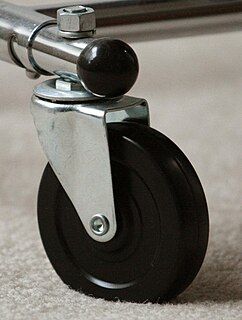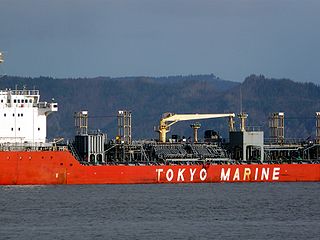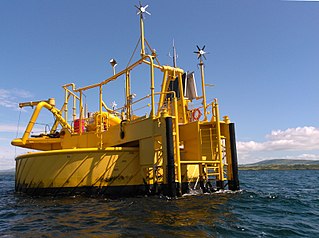
A truss is an assembly of beams or other elements that creates a rigid structure.

A caster is an undriven wheel that is designed to be attached to the bottom of a larger object to enable that object to be moved.

Hydraulic machines use liquid fluid power to perform work. Heavy construction vehicles are a common example. In this type of machine, hydraulic fluid is pumped to various hydraulic motors and hydraulic cylinders throughout the machine and becomes pressurized according to the resistance present. The fluid is controlled directly or automatically by control valves and distributed through hoses, tubes, or pipes.

A chemical tanker is a type of tanker ship designed to transport chemicals in bulk. As defined in MARPOL Annex II, chemical tanker means a ship constructed or adapted for carrying in bulk any liquid product listed in chapter 17 of the International Bulk Chemical Code. As well as industrial chemicals and clean petroleum products, such ships also often carry other types of sensitive cargo which require a high standard of tank cleaning, such as palm oil, vegetable oils, tallow, caustic soda, and methanol.

A tanker is a ship designed to transport or store liquids or gases in bulk. Major types of tankship include the oil tanker, the chemical tanker, and gas carrier. Tankers also carry commodities such as vegetable oils, molasses and wine. In the United States Navy and Military Sealift Command, a tanker used to refuel other ships is called an oiler but many other navies use the terms tanker and replenishment tanker.

An oil terminal is an industrial facility for the storage of oil, petroleum and petrochemical products, and from which these products are transported to end users or other storage facilities. An oil terminal typically has a variety of above or below ground tankage; facilities for inter-tank transfer; pumping facilities; loading gantries for filling road tankers or barges; ship loading/unloading equipment at marine terminals; and pipeline connections.

Marine engineering includes the engineering of boats, ships, oil rigs and any other marine vessel or structure, as well as oceanographic engineering, oceanic engineering or nautical engineering. Specifically, marine engineering is the discipline of applying engineering sciences, including mechanical engineering, electrical engineering, electronic engineering, and computer science, to the development, design, operation and maintenance of watercraft propulsion and on-board systems and oceanographic technology. It includes but is not limited to power and propulsion plants, machinery, piping, automation and control systems for marine vehicles of any kind, such as surface ships and submarines.

A pipe is a tubular section or hollow cylinder, usually but not necessarily of circular cross-section, used mainly to convey substances which can flow — liquids and gases (fluids), slurries, powders and masses of small solids. It can also be used for structural applications; hollow pipe is far stiffer per unit weight than solid members.

A fitting or adapter is used in pipe systems to connect straight sections of pipe or tube, adapt to different sizes or shapes, and for other purposes such as regulating fluid flow. These fittings are used in plumbing to manipulate the conveyance of water, gas, or liquid waste in domestic or commercial environments, within a system of pipes or tubes.

Marine Transfer Operations are conducted at many ports around the world between tanker ships, barges, and marine terminals. Specifically, once the marine vessel is secure at the dock a loading arm or transfer hose is connected between a valve header on the dock and the manifold header on the vessel. A marine transfer of petroleum products cannot be conducted unless it is supervised by a person-in-charge (PIC) on the vessel who is seafarer in the Merchant Marine and another person-in-charge on the dock.

The M970 Semi-Trailer Refueler is a 5,000-U.S.-gallon fuel dispensing tanker designed for under/overwing refueling of aircraft. It is equipped with a filter/separator, recirculation system and two refueling systems, one for underwing and one for overwing servicing. The tanker is designed to be towed by a 5-ton, 6x6 truck tractor or similar vehicle equipped with a fifth wheel. The M970 can be loaded through the bottom or through the top fill openings. A ladder is provided at the front of the semitrailer for access to the top manhole, and a 4-cylinder diesel engine and pump assembly provides self load/unload capability. The body of the refueler is a 5,000-U.S.-gallon, single compartment, stainless steel tank. The chassis is of welded steel construction and is equipped with full floating tandem axles and a manually operated landing gear. There has been talk of retiring the M970, but a suitable off-road replacement has not been found. The Marine Corps also uses R-9 and R-10 tankers, but they are not capable of off road use. The M970 is a part of the "United States Marine Corps Maintenance Center - Albany, Georgia, USA - An Integrated Enterprise Scheduling Case Study" which is working to upgrade the Semitrailer for future use.

A Single buoy mooring (SrM) is a loading buoy anchored offshore, that serves as a mooring point and interconnect for tankers loading or offloading gas or liquid products. SPMs are the link between geostatic subsea manifold connections and weathervaning tankers. They are capable of handling any tonnage ship, even very large crude carriers (VLCC) where no alternative facility is available.

An oil tanker, also known as a petroleum tanker, is a ship designed for the bulk transport of oil or its products. There are two basic types of oil tankers: crude tankers and product tankers. Crude tankers move large quantities of unrefined crude oil from its point of extraction to refineries. Product tankers, generally much smaller, are designed to move refined products from refineries to points near consuming markets.

A tank container or tanktainer is an intermodal container for the transport of liquids, gases and powders as bulk cargo. It is built to the ISO standards, making it suitable for different modes of transportation; as such, it is also called an ISO tank. Both hazardous and non-hazardous products can be transported in tank containers.

A marine loading arm, also known as a mechanical loading arm, loading arm, or MLA is a mechanical arm consisting of articulated steel pipes that connect a tankship such as an oil tanker or chemical tanker to a cargo terminal. Genericized trademarks such as Chiksan are often used to refer to marine loading arms.

An external floating roof tank is a storage tank commonly used to store large quantities of petroleum products such as crude oil or condensate. It consists of an open- topped cylindrical steel shell equipped with a roof that floats on the surface of the stored liquid. The roof rises and falls with the liquid level in the tank. As opposed to a fixed roof tank there is no vapor space (ullage) in the floating roof tank. In principle, this eliminates tank breathing loss and greatly reduces the evaporative loss of the stored liquid. There is a rim seal system between the tank shell and roof to reduce rim evaporation.

The cargo control room, CCR, or cargo office of a tankship is where the person in charge (PIC) can monitor and control the loading and unloading of the ship's liquid cargo. Prevalent on automated vessels, the CCR may be in its own room, or located on the ship's bridge. Among other things, the equipment in the CCR may allow the person in charge to control cargo and stripping pumps, control and monitor valve positions, and monitor cargo tank liquid levels.
A gas carrier is a ship designed to transport LPG, LNG, CNG, or liquefied chemical gases in bulk.

A liquefied natural gas terminal is a facility for managing the import and/or export of liquefied natural gas (LNG). It comprises equipment for loading and unloading of LNG cargo to/from ocean-going tankers, for transfer across the site, liquefication, re-gasification, processing, storage, pumping, compression, and metering of LNG. LNG as a liquid is the most efficient way to transport natural gas over long distances, usually by sea.
The Thistle SALM was a tanker loading facility that allowed oil from the Thistle oilfield to be transported to land where a submarine export pipeline did not yet exist. It was also the site of the August 8, 1979 Wildrake diving accident that killed two divers. and the January 21, 1981 Stena Seaspread diving accident (non-fatal).






















